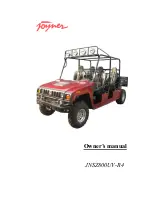
4
ARI Motors GmbH •
Important information
ABOUT THE VEHICLE
Even with an electric vehicle, energy-saving driving is synonymous with anticipatory
driving. As with a vehicle with a combustion engine, this vehicle consumes more energy
at high acceleration, at high driving speeds and on inclines. It is therefore an advantage
to watch the traffic with foresight and avoid unnecessary acceleration. It is also advisable
to let the vehicle coast more often, as the vehicle battery gains energy through
recuperation. This is not caused by braking energy, as is the case with a recuperation
brake, but by the free rotation of the engine or the rolling of the vehicle. In this way, the
battery can easily be recharged a little on a slope. Continuously depressing the
accelerator pedal and the associated maximum possible speed lead to a faster discharge
of the battery and is therefore not recommended if a long range is to be achieved.
ENERG
Y-EFFICIENT DRIVING
1.) Every vehicle has a frame number and an engine number to enable easier
maintenance and, if necessary, repairs. The frame number is on the lower part of the
front housing, the engine number is printed on the outer shell of the electric motor.
2.) The front rack should be loaded with a maximum of 35 kilograms, the rear with a
maximum of 70 kilograms. Note the changed road position of the vehicle with a
higher load. If the load is too high, a strong
vibration of the handles occurs.
Therefore, always stick to the maximum payload.
3.) Do not place any flammable materials directly next to the electric motor.
4.) Only place cargo on the two luggage racks provided.
5.) Check the brakes, all connecting elements and the power supply before every
journey.
6.) When washing the vehicle, avoid spraying the brake drum, the engine and the axles
directly with water in order to increase their service life. Do not use high pressure or
steam cleaners when washing the vehicle.
7.) This vehicle is intended for one person. In addition, never exceed the maximum
payload of the vehicle.
8.) Check the air pressure in the tires and adjust it in good time. The prescribed tire
pressure is 2.8 bar for the front and rear tires. Check the tire pressure when it is not
heated.
9.) The battery power has the most optimal conditions at 20 degrees Celsius. Colder
temperatures ensure a higher internal resistance in the battery. This leads to the
range and capacity being reduced (e.g. at -8 degrees by approx. 25%). Likewise, the
range is reduced when consumers like the
main lights are switched on.


































